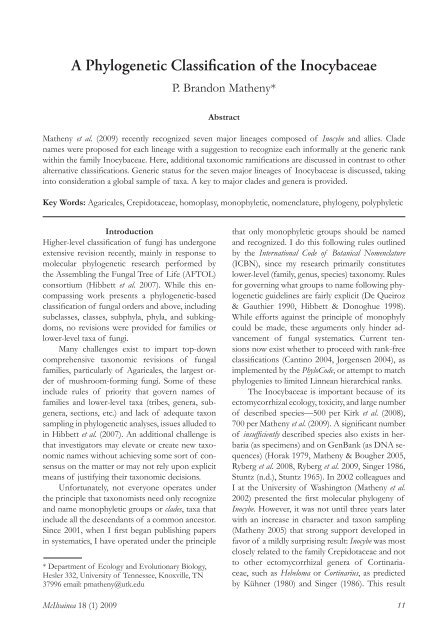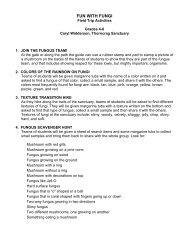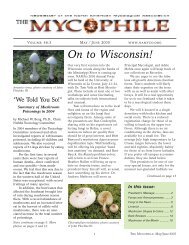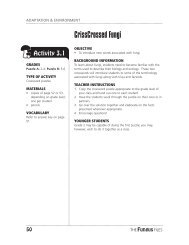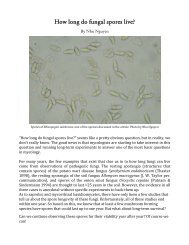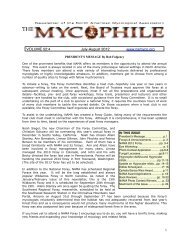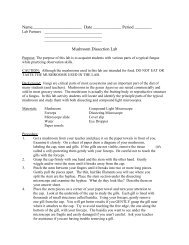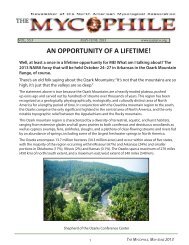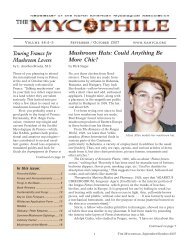A Phylogenetic Classification of the Inocybaceae - North American ...
A Phylogenetic Classification of the Inocybaceae - North American ...
A Phylogenetic Classification of the Inocybaceae - North American ...
Create successful ePaper yourself
Turn your PDF publications into a flip-book with our unique Google optimized e-Paper software.
Volume 18, Number 1, 2009 11<br />
A <strong>Phylogenetic</strong> <strong>Classification</strong> <strong>of</strong> <strong>the</strong> <strong>Inocybaceae</strong><br />
P. Brandon Ma<strong>the</strong>ny*<br />
Abstract<br />
Ma<strong>the</strong>ny et al. (2009) recently recognized seven major lineages composed <strong>of</strong> Inocybe and allies. Clade<br />
names were proposed for each lineage with a suggestion to recognize each informally at <strong>the</strong> generic rank<br />
within <strong>the</strong> family <strong>Inocybaceae</strong>. Here, additional taxonomic ramifications are discussed in contrast to o<strong>the</strong>r<br />
alternative classifications. Generic status for <strong>the</strong> seven major lineages <strong>of</strong> <strong>Inocybaceae</strong> is discussed, taking<br />
into consideration a global sample <strong>of</strong> taxa. A key to major clades and genera is provided.<br />
Key Words: Agaricales, Crepidotaceae, homoplasy, monophyletic, nomenclature, phylogeny, polyphyletic<br />
Introduction<br />
Higher-level classification <strong>of</strong> fungi has undergone<br />
extensive revision recently, mainly in response to<br />
molecular phylogenetic research performed by<br />
<strong>the</strong> Assembling <strong>the</strong> Fungal Tree <strong>of</strong> Life (AFTOL)<br />
consortium (Hibbett et al. 2007). While this encompassing<br />
work presents a phylogenetic-based<br />
classification <strong>of</strong> fungal orders and above, including<br />
subclasses, classes, subphyla, phyla, and subkingdoms,<br />
no revisions were provided for families or<br />
lower-level taxa <strong>of</strong> fungi.<br />
Many challenges exist to impart top-down<br />
comprehensive taxonomic revisions <strong>of</strong> fungal<br />
families, particularly <strong>of</strong> Agaricales, <strong>the</strong> largest order<br />
<strong>of</strong> mushroom-forming fungi. Some <strong>of</strong> <strong>the</strong>se<br />
include rules <strong>of</strong> priority that govern names <strong>of</strong><br />
families and lower-level taxa (tribes, genera, subgenera,<br />
sections, etc.) and lack <strong>of</strong> adequate taxon<br />
sampling in phylogenetic analyses, issues alluded to<br />
in Hibbett et al. (2007). An additional challenge is<br />
that investigators may elevate or create new taxonomic<br />
names without achieving some sort <strong>of</strong> consensus<br />
on <strong>the</strong> matter or may not rely upon explicit<br />
means <strong>of</strong> justifying <strong>the</strong>ir taxonomic decisions.<br />
Unfortunately, not everyone operates under<br />
<strong>the</strong> principle that taxonomists need only recognize<br />
and name monophyletic groups or clades, taxa that<br />
include all <strong>the</strong> descendants <strong>of</strong> a common ancestor.<br />
Since 2001, when I first began publishing papers<br />
in systematics, I have operated under <strong>the</strong> principle<br />
* Department <strong>of</strong> Ecology and Evolutionary Biology,<br />
Hesler 332, University <strong>of</strong> Tennessee, Knoxville, TN<br />
37996 email: pma<strong>the</strong>ny@utk.edu<br />
that only monophyletic groups should be named<br />
and recognized. I do this following rules outlined<br />
by <strong>the</strong> International Code <strong>of</strong> Botanical Nomenclature<br />
(ICBN), since my research primarily constitutes<br />
lower-level (family, genus, species) taxonomy. Rules<br />
for governing what groups to name following phylogenetic<br />
guidelines are fairly explicit (De Queiroz<br />
& Gauthier 1990, Hibbett & Donoghue 1998).<br />
While efforts against <strong>the</strong> principle <strong>of</strong> monophyly<br />
could be made, <strong>the</strong>se arguments only hinder advancement<br />
<strong>of</strong> fungal systematics. Current tensions<br />
now exist whe<strong>the</strong>r to proceed with rank-free<br />
classifications (Cantino 2004, Jørgensen 2004), as<br />
implemented by <strong>the</strong> PhyloCode, or attempt to match<br />
phylogenies to limited Linnean hierarchical ranks.<br />
The <strong>Inocybaceae</strong> is important because <strong>of</strong> its<br />
ectomycorrhizal ecology, toxicity, and large number<br />
<strong>of</strong> described species—500 per Kirk et al. (2008),<br />
700 per Ma<strong>the</strong>ny et al. (2009). A significant number<br />
<strong>of</strong> insufficiently described species also exists in herbaria<br />
(as specimens) and on GenBank (as DNA sequences)<br />
(Horak 1979, Ma<strong>the</strong>ny & Bougher 2005,<br />
Ryberg et al. 2008, Ryberg et al. 2009, Singer 1986,<br />
Stuntz (n.d.), Stuntz 1965). In 2002 colleagues and<br />
I at <strong>the</strong> University <strong>of</strong> Washington (Ma<strong>the</strong>ny et al.<br />
2002) presented <strong>the</strong> first molecular phylogeny <strong>of</strong><br />
Inocybe. However, it was not until three years later<br />
with an increase in character and taxon sampling<br />
(Ma<strong>the</strong>ny 2005) that strong support developed in<br />
favor <strong>of</strong> a mildly surprising result: Inocybe was most<br />
closely related to <strong>the</strong> family Crepidotaceae and not<br />
to o<strong>the</strong>r ectomycorrhizal genera <strong>of</strong> Cortinariaceae,<br />
such as Hebeloma or Cortinarius, as predicted<br />
by Kühner (1980) and Singer (1986). This result<br />
McIlvainea 18 (1) 2009 11
12<br />
McIlvainea<br />
was reinforced by phylogenetic analysis <strong>of</strong> a dense<br />
DNA character supermatrix (six and three gene<br />
regions) for 274 and 175 species <strong>of</strong> Agaricales and<br />
outgroups (Ma<strong>the</strong>ny et al. 2006). An independent<br />
data matrix <strong>of</strong> two genes and analysis by Garnica<br />
and colleagues (Garnica et al. 2007) also suggests<br />
that Inocybe and <strong>the</strong> Crepidotaceae are each o<strong>the</strong>r’s<br />
closest relatives, viz. sister groups.<br />
A close relationship between Inocybe and Crepidotaceae<br />
was somewhat surprising because Inocybe<br />
is ectomycorrhizal, whereas <strong>the</strong> Crepidotaceae,<br />
recently itself revised by molecular phylogenetic<br />
analysis (Aime et al. 2005), is saprotrophic. Many<br />
species <strong>of</strong> <strong>Inocybaceae</strong> are also pharmacologically<br />
important because <strong>of</strong> <strong>the</strong>ir high concentration <strong>of</strong><br />
muscarine (Brown et al. 1962, Stijve 1982, Malone<br />
& Brady 1987); species <strong>of</strong> Crepidotaceae do not<br />
contain <strong>the</strong> toxin (Benjamin 1995). The remainder<br />
<strong>of</strong> this paper will address decisions to promote Inocybe<br />
at a family rank and examine several alternative<br />
and recently proposed classifications.<br />
Overview <strong>of</strong> Inocybe <strong>Classification</strong><br />
The genus Inocybe was originally conceived by Fries<br />
in 1821 as a “tribe” in <strong>the</strong> broad encompassing<br />
mushroom genus Agaricus. Today Fries’s wide<br />
concept <strong>of</strong> Agaricus contains numerous families<br />
or clades, i.e., monophyletic groups, <strong>of</strong> Agaricales<br />
(Moncalvo et al. 2000, 2002, Ma<strong>the</strong>ny et al. 2007a).<br />
In 1863 Fries elevated Inocybe to generic rank. This<br />
was done in response to observations by o<strong>the</strong>rs<br />
that <strong>the</strong> basidiospores <strong>of</strong> some common species<br />
<strong>of</strong> Inocybe were unique by virtue <strong>of</strong> <strong>the</strong>ir nodulose,<br />
angular, or spinose state (Singer 1986), hereafter<br />
simply referred to as nodulose.<br />
Later, Schroeter (1889) and Fayod (1889)<br />
simultaneously segregated nodulose-spored Inocybe<br />
from smooth-spored species and treated <strong>the</strong> former<br />
in <strong>the</strong> genus Astrosporina J. Schroet. or Clypeus<br />
(Britz.) Fayod, respectively. Because Astrosporina<br />
was published just before publication <strong>of</strong> Clypeus<br />
at <strong>the</strong> generic rank, <strong>the</strong> name Clypeus is superfluous<br />
as a genus name and is treated as a synonym<br />
<strong>of</strong> Astrosporina according to rules <strong>of</strong> <strong>the</strong> ICBN.<br />
In contrast to Schroeter and Fayod, most subsequent<br />
taxonomic agaricologists followed Fries<br />
and treated Inocybe as a single genus encompassing<br />
both smooth- and nodulose-spored taxa. There<br />
were at least two exceptions to this, however: (i)<br />
Earle (1909), who recognized four genera <strong>of</strong> Inocybe<br />
(Agmocybe, Astrosporina, Inocybe, and Inocibium;<br />
and (ii) Horak (1967, 1979, 1980, 1981, 1987),<br />
who followed Schroeter (and essentially Fayod) in<br />
maintaining Astrosporina as a genus distinct from<br />
smooth-spored species <strong>of</strong> Inocybe.<br />
Kühner (1980) argued against recognition <strong>of</strong><br />
Astrosporina concluding that a subgeneric arrangement<br />
in Inocybe was best maintained if one stressed<br />
qualitative or discrete characters (e.g., <strong>the</strong> presence<br />
or absence <strong>of</strong> pleurocystidia) ra<strong>the</strong>r than quantitative<br />
or continuous characters (degree <strong>of</strong> uneven<br />
basidiospore wall topology). Kühner’s argument<br />
was insightful from a biological point <strong>of</strong> view because<br />
intermediates between smooth- and nodulose-spored<br />
species could be found, e.g., I. curvipes<br />
and I. lacera, that questioned <strong>the</strong> hiatus between<br />
smooth- and nodulose-spored taxa. Thus, Kühner<br />
proposed subgenus Inosperma to encompass<br />
species <strong>of</strong> Inocybe lacking pleurocystidia (and having<br />
smooth spores) and circumscribed subgenus<br />
Inocybe to accommodate species with pleurocystidia<br />
(and having smooth or nodulose spores). No<br />
higher-level taxa were recognized that separated<br />
smooth- from nodulose-spored taxa. In effect,<br />
Kühner hypo<strong>the</strong>sized that presence <strong>of</strong> pleurocystidia<br />
was a shared derived trait for species <strong>of</strong> subgenus<br />
Inocybe, a unique character state acquisition<br />
depicted in Figure 1A. In contrast, translation <strong>of</strong><br />
Horak’s classification <strong>of</strong> Inocybe into a phylogenetic<br />
hypo<strong>the</strong>sis suggests that possession <strong>of</strong> nodulose<br />
spores is a diagnostic trait for Astrosporina (Fig. 1B).<br />
In a cladistic framework, shared derived traits, or<br />
synapomorphies, are evidence <strong>of</strong> monophyly. However,<br />
absence <strong>of</strong> a particular trait may be problematic,<br />
if its absence is considered <strong>the</strong> ancestral state<br />
(symplesiomorphic). Symplesiomorphic traits suggest<br />
paraphyletic groups: those that include descendants<br />
originally excluded from <strong>the</strong> group under<br />
question. Fish is a great example <strong>of</strong> a paraphyletic<br />
group because tetrapods are derived within <strong>the</strong> fish<br />
clade. Dicots and dinosaurs are two additional examples<br />
<strong>of</strong> paraphyletic groups because monocots<br />
are nested in dicots, and birds are derived from dinosaurs.<br />
Non-monophyletic groups, unfortunately,<br />
produce nomenclatural quandaries.<br />
Cladistic analyses using morphological data<br />
(Kuyper 1986) provided important evidence that<br />
corroborates Kühner’s hypo<strong>the</strong>sis to some extent.<br />
Subgenus Inocybe was found to be monophyletic<br />
based on two shared derived features (Fig. 1C),
Volume 18, Number 1, 2009 13<br />
Fig. 1. A–D. Cladistic summaries <strong>of</strong> different family or genus level classifications<br />
<strong>of</strong> Inocybe and allies. Shared derived traits are indicated by thick gray bars.<br />
Share ancestral traits are included without gray bars. Bon’s classification (1997)<br />
is <strong>the</strong> same as Singer’s (1D) except for nomenclatural differences due to a disagreement<br />
over <strong>the</strong> generic type.<br />
and taxa with nodulose<br />
spores were found to have<br />
evolved independently on<br />
multiple occasions, predictions<br />
implicitly made<br />
by Kühner. Kuyper’s<br />
results also confirmed<br />
that subgenus Inosperma,<br />
as originally conceived<br />
by Kühner, is paraphyletic.<br />
Kuyper, however,<br />
found evidence for <strong>the</strong><br />
monophyly <strong>of</strong> a group<br />
<strong>of</strong> species surrounding I.<br />
terrigena, which he named<br />
subgenus Mallocybe. This<br />
group was distinguished<br />
from o<strong>the</strong>rs due to presence<br />
<strong>of</strong> two synapomorphies—necropigmented<br />
basidia and unique origin<br />
<strong>of</strong> cheilocystidia. Necrobasidia<br />
are easy to observe<br />
under <strong>the</strong> microscope as<br />
<strong>the</strong>se collapse and become<br />
ochraceous after spore release. Thus, Kühner’s<br />
problem <strong>of</strong> a paraphyletic subgenus Inosperma<br />
was solved with removal and naming <strong>of</strong> <strong>the</strong> lineage<br />
containing I. terrigena and allies. Kuyper’s analysis<br />
also suggested that subgenus Inosperma s. str. could<br />
be monophyletic or paraphyletic and that phaseoliform<br />
spores might be a shared derived state or<br />
shared ancestral state for <strong>the</strong> group, depending on<br />
<strong>the</strong> group’s relationship to elliptic-spored species<br />
surrounding <strong>the</strong> I. rimosa complex.<br />
Singer’s classification (Singer 1986) is essentially<br />
a blend <strong>of</strong> Kühner’s and Horak’s classifications<br />
except nodulose-spored species are classified<br />
at a subgeneric rank (subg. Inocybe) ra<strong>the</strong>r than<br />
genus rank. Singer’s nomenclatural decision (not<br />
taxonomic) was based on observations by Moser<br />
(1978) that <strong>the</strong> type <strong>of</strong> Inocybe, I. relicina, has nodulose<br />
spores in contrast to Heim’s interpretation <strong>of</strong><br />
this species in 1931. Horak (1967) had considered<br />
I. geophylla (smooth spores) as type <strong>of</strong> Inocybe. However,<br />
since Moser’s publication <strong>the</strong>re has been no<br />
debate about what constitutes <strong>the</strong> type <strong>of</strong> Inocybe<br />
with <strong>the</strong> exception <strong>of</strong> Bon (1997). Note that subgenus<br />
Inocibium (Fig. 1D) is recognized as a unique<br />
taxon in Singer’s system, but no characters are provided<br />
that diagnose <strong>the</strong> group exclusively. Hence,<br />
one might predict that sugb. Inocibium (similar to<br />
Kühner’s conception <strong>of</strong> subgenus Inosperma) is not<br />
monophyletic. Also note that Singer (1986) classified<br />
Inocybe, a single genus, as its own tribe, <strong>the</strong> Inocybeae,<br />
one <strong>of</strong> three tribes in his Cortinariaceae.<br />
Lastly, we must consider that Jülich (1982)<br />
elevated tribe Inocybeae to <strong>the</strong> family rank,<br />
<strong>Inocybaceae</strong>. In it Jülich simply applied Horak’s<br />
classification (Fig. 1B) that circumscribed two<br />
genera, Astrosporina and Inocybe. Astrosporina was<br />
distinguished by spore walls with an “exosporial<br />
ornamentation.”<br />
Molecular <strong>Phylogenetic</strong> Analyses<br />
<strong>of</strong> Inocybe<br />
This brings us back to <strong>the</strong> beginning <strong>of</strong> our story.<br />
Molecular data support recognition <strong>of</strong> a clade, Inocybe<br />
sensu lato, which is sister to <strong>the</strong> Crepidotaceae<br />
sensu stricto. O<strong>the</strong>r analyses (Moncalvo et al. 2000,<br />
2002, Ma<strong>the</strong>ny et al. 2006, Garnica et al. 2007) indicate<br />
<strong>the</strong> polyphyly, or independent origin <strong>of</strong> multiple<br />
groups that do not share a most recent common<br />
ancestor, <strong>of</strong> <strong>the</strong> family Cortinariaceae, <strong>the</strong> family<br />
in which Inocybe was traditionally classified. Thus,
14<br />
McIlvainea<br />
I suggested re-recognition <strong>of</strong> Inocybe at <strong>the</strong> family<br />
level (Ma<strong>the</strong>ny 2005), as was formally validated by<br />
Jülich (1982). This results in a sister group arrangement<br />
<strong>of</strong> equal ranks (<strong>the</strong> <strong>Inocybaceae</strong> and Crepidotaceae)<br />
and contributes to <strong>the</strong> dismemberment<br />
<strong>of</strong> <strong>the</strong> highly polyphyletic Cortinariaceae. Incidentally,<br />
<strong>the</strong> name <strong>Inocybaceae</strong> is a valid family name<br />
as long as Inocybe is withdrawn from <strong>the</strong> Cortinariaceae,<br />
against which <strong>the</strong> Cortinariaceae is conserved<br />
(Pouzar 1985).<br />
A close relationship between <strong>the</strong> Crepidotaceae<br />
sensu stricto and <strong>Inocybaceae</strong> presents a novel<br />
sister group relationship in <strong>the</strong> Agaricales, an arrangement<br />
first suggested by Moncalvo et al. (2002)<br />
but without strong statistical support. The two<br />
families differ substantially in <strong>the</strong>ir mode <strong>of</strong> nutrition<br />
but also differ in mode <strong>of</strong> development, spore<br />
karyology, and pharmacology (Table 1). However,<br />
both families do bear several similarities: spore<br />
deposit colors (dull brown), challenges in cultivation,<br />
and general absence <strong>of</strong> asexual reproductive<br />
propagules (but see Clemençon 2000). Members<br />
<strong>of</strong> Crepidotus and Simocybe require a period <strong>of</strong><br />
basidiospore dormancy before germination (Senn-<br />
Irlet 1994, Aime 1999, Aime & Miller 2002), but<br />
spores <strong>of</strong> <strong>Inocybaceae</strong> are notoriously difficult to<br />
germinate (Fries 1982). Species <strong>of</strong> Simocybe and<br />
some Crepidotus share spore shapes (phaseoliform)<br />
similar to species <strong>of</strong> non-pleurocystidiate clades <strong>of</strong><br />
<strong>Inocybaceae</strong>. This could suggest that phaseoliform<br />
spores might be a shared ancestral state in <strong>the</strong> <strong>Inocybaceae</strong><br />
and Crepidotaceae clade, a topic that has<br />
not been explored. Additional similarities in cheilocystidia<br />
morphology occur between Simocybe and<br />
Auritella (Ma<strong>the</strong>ny & Bougher 2006). O<strong>the</strong>r characters<br />
for this inclusive group, whe<strong>the</strong>r anatomical,<br />
physiological, or biochemical, require exploration<br />
using molecular phylogenetic hypo<strong>the</strong>ses.<br />
So, based on present evidence, Inocybe and<br />
allies are not closely related to Cortinarius or Hebeloma,<br />
genera that share some fruit body anatomical<br />
similarities with <strong>the</strong> <strong>Inocybaceae</strong> (filamentous<br />
pileipellis, presence <strong>of</strong> clamps, pigmented spores).<br />
Kühner (1984) pointed to a similar biology (ectomycorrhizal<br />
status) between Cortinarius, Hebeloma,<br />
and Inocybe as evidence for shared ancestry. Kühner<br />
also suggested a close relationship between Cortinarius<br />
and Inocybe justified by presence <strong>of</strong> similar violet<br />
cytoplasmic pigmentation and an ochraceous<br />
spore wall. These superficial similarities, however,<br />
are called homoplasies (or homolplasy in <strong>the</strong> singular),<br />
characters that are in conflict with <strong>the</strong> inferred<br />
phylogeny.<br />
Should Inocybe Be Divided into<br />
Multiple Genera?<br />
Ma<strong>the</strong>ny et al. (2009) recently produced a multigene<br />
phylogenetic analysis that unveiled seven<br />
major clades in <strong>the</strong> family, a summary <strong>of</strong> which is<br />
shown as a chronogram in Figure 2. It is ultimately<br />
an arbitrary choice whe<strong>the</strong>r <strong>the</strong> seven clades <strong>of</strong><br />
<strong>the</strong> <strong>Inocybaceae</strong> are recognized at an infrageneric<br />
or sectional level, which would be consistent with<br />
some systematic treatments <strong>of</strong> Inocybe (Heim 1931,<br />
Kühner & Romagnesi 1953, Kühner 1980, Kuyper<br />
1986, Singer 1986), or at <strong>the</strong> generic level, which<br />
would be consistent with o<strong>the</strong>rs (Fayod 1889,<br />
Karsten 1889, Schroeter 1889, Earle 1909, Horak<br />
1967, Jülich 1982, Ma<strong>the</strong>ny 2005, Ma<strong>the</strong>ny et al.<br />
2009). The major groups recognized are monophyletic,<br />
a principle by which taxa are named and<br />
recognized (Kuyper 1994, Vilgalys et al. 1994,<br />
Singer 1994, Hibbett & Donoghue 1998). O<strong>the</strong>r<br />
authors, such as Watling (2001), suggested that<br />
subgenus Mallocybe might warrant a unique generic<br />
disposition based only on morphological data.<br />
Thus, recognition <strong>of</strong> different groups <strong>of</strong> Inocybe at<br />
generic ranks is hardly novel.<br />
Ultimately, I favor generic recognition <strong>of</strong> <strong>the</strong><br />
seven inocyboid clades identified in this study and<br />
in Ma<strong>the</strong>ny et al. (2009) for reasons enumerated<br />
below, but pause to make <strong>the</strong>se changes until data<br />
from undescribed and poorly known species come<br />
to light:<br />
(1) The <strong>Inocybaceae</strong> is an ancient lineage that<br />
diversified between 99 and 191 million years ago<br />
(Fig. 2; Ma<strong>the</strong>ny et al. 2009). Initial diversification<br />
<strong>of</strong> <strong>the</strong> family pre-dated <strong>the</strong> K-Pg (Cretaceous-<br />
Paleogene) boundary but a star-burst radiation<br />
probably occurred during <strong>the</strong> Paleogene. The <strong>Inocybaceae</strong><br />
is likely older than o<strong>the</strong>r ectomycorrhizal<br />
genera <strong>of</strong> Agaricales such as Hebeloma and Alnicola,<br />
and is just as old, if not probably older, than o<strong>the</strong>r<br />
ectomycorrhizal families <strong>of</strong> Boletales, such as <strong>the</strong><br />
Pinaceae-specific Suillaceae.<br />
(2) Discrete morphological traits can be used<br />
to distinguish Inocybe sensu stricto from non-pleurocystidiate<br />
clades similar to arrangements <strong>of</strong> sister<br />
genera Pleurotus and Hohenbuehelia (Thorn et al.<br />
2000), now <strong>the</strong> Pleurotaceae, and many polyporoid
Volume 18, Number 1, 2009 15<br />
Table 1. Ecological and morphological comparison between Crepidotaceae and<br />
<strong>Inocybaceae</strong><br />
Characters Crepidotaceae <strong>Inocybaceae</strong><br />
Nutritional mode Saprotrophic Ectomycorrhizal<br />
Development Gymnocarpic or veil Variable, mostly monoscarcely<br />
developed<br />
velangiocarpus and pileostipitocarpus,<br />
also stipitocarpous<br />
or bivelangiocarpus<br />
Clamp connections Present or absent Present<br />
Spore deposit Pale yellow to brown Brown (rarely white)<br />
Pileipellis Filamentous, at times Filamentous, few species with<br />
gelatinous, or with distinct<br />
pileocystidia<br />
pseudoparenchymatous subpellis,<br />
usually without distinct pileocystidia<br />
Cheilocystidia Always present, uniform Heteromorphic in most species—<br />
paracystidia mixed with thickwalled<br />
cystidia<br />
Pleurocystidia Mostly absent but rarely Present in most species,<br />
thick-walled or originating<br />
(sub)hymenial origin, probably<br />
from lamellar trama<br />
modified basidia<br />
Germ pore Absent Absent (rarely present)<br />
Spore topology Smooth or ornamented, Smooth or angular, wall protruding<br />
never angular or reticulate<br />
to form nodules or spines, never<br />
ornamented<br />
Spore karyology Uni- or binucleate Binucleate<br />
Anamorphic states Infrequent None observed<br />
Spore germination Dormancy required Fail to germinate on standard agar<br />
plates<br />
Pharmacology No major toxins identified Muscarine, psilocybin,<br />
aeruginascen, unclarified alkaloids,<br />
or none<br />
and resupinate genera (Jülich & Stalpers 1980, Gilbertson<br />
& Ryvarden 1986).<br />
(3) Communication about fungal diversity<br />
would be facilitated and improved by reference<br />
to genera or major clades instead <strong>of</strong> infrageneric<br />
ranks that have been variously interpreted by many<br />
authors (Heim 1931, Kühner 1980, Kuyper 1986,<br />
Singer 1986, Bon 1997, Kobayashi 2002). Recognition<br />
<strong>of</strong> <strong>the</strong> seven major lineages as genera or clades<br />
would no longer be encumbered by multiple interpretations<br />
<strong>of</strong> infrageneric names.<br />
(4) Few new combinations at <strong>the</strong> specific level<br />
are necessary if Inocybe were split into multiple genera<br />
because Inocybe sensu stricto contains <strong>the</strong> bulk<br />
(about 85%) <strong>of</strong> Inocybe species, as extrapolated<br />
from a reasonable well-sampled German myc<strong>of</strong>lora<br />
(Stangl 1989). Thus, <strong>the</strong> nomenclature for<br />
<strong>the</strong> overwhelming majority <strong>of</strong> species would not<br />
change, which would counter arguments in favor<br />
<strong>of</strong> nomenclatural stability.<br />
(5) Though taxon sampling <strong>of</strong> Inocybe species<br />
has not been exhaustive, <strong>the</strong> system proposed here
16<br />
McIlvainea<br />
contains <strong>the</strong> highest predictive value to date for<br />
<strong>the</strong> evolution <strong>of</strong> inocyboid taxa. Additional taxon<br />
sampling might uncover additional clades or help<br />
resolve and support <strong>the</strong>ir inter-relationships, but<br />
<strong>the</strong> names <strong>of</strong> <strong>the</strong> major clades will not change.<br />
(6) A bias exists unnecessarily in favor <strong>of</strong> large<br />
agaric genera (Smith & Hesler 1968, Romagnesi<br />
1977). One encompassing genus Inocybe undermines<br />
<strong>the</strong> phylogenetic diversity uncovered in <strong>the</strong><br />
clade and its sister position to <strong>the</strong> Crepidotaceae.<br />
In short, a subgeneric classification would, in my<br />
opinion, fail to facilitate future studies that attempt<br />
to explore <strong>the</strong> evolution, biodiversity, ecology, and<br />
genomics <strong>of</strong> <strong>the</strong> group.<br />
(7) Inocybe s. lato appears to be paraphyletic.<br />
However, <strong>the</strong> monophyly <strong>of</strong> Inocybe and a possible<br />
sister position to Auritella cannot be rejected using<br />
a statistical approach (Ryberg 2009).<br />
Distinguishing Features <strong>of</strong> Each Major Clade<br />
<strong>of</strong> <strong>Inocybaceae</strong><br />
Auritella is distinguished by its geographic distribution<br />
(known only from <strong>the</strong> wet tropics <strong>of</strong><br />
west Africa and temperate parts <strong>of</strong> Australia),<br />
typically tough fruit bodies, long cheilocystidia,<br />
necropigmented basidia, mostly elliptic, cylindrical,<br />
or globose smooth spores, lack <strong>of</strong> pleurocystidia,<br />
and non-rubescent context (Ma<strong>the</strong>ny & Bougher<br />
2006). It is not known whe<strong>the</strong>r any <strong>of</strong> <strong>the</strong> known<br />
seven species contain muscarine. Auritella is a relict<br />
lineage that first split between African and Australian<br />
lineages about 70 million years ago. Plant<br />
associations for this genus probably include genera<br />
<strong>of</strong> Fabaceae and Myrtaceae.<br />
The Mallocybella clade is known only by<br />
two species, one <strong>of</strong> which is undescribed and<br />
poorly characterized from Zambia (Villarreal et<br />
al. 1998, Ma<strong>the</strong>ny et al. 2009). This pair <strong>of</strong> species<br />
groups toge<strong>the</strong>r on a consistent basis but is<br />
not significantly supported by statistical analyses.<br />
Never<strong>the</strong>less, its present geographic distribution<br />
includes <strong>the</strong> Mediterranean area <strong>of</strong> Europe (Spain<br />
and Corsica; see Moreau et al. 2007) and dry tropical<br />
Africa (Zambia). Salient features <strong>of</strong> <strong>the</strong> clade<br />
might include abundant caulocystidia and possibly<br />
small fruit body size. Both species associate with<br />
angiosperms—Cistaceae in <strong>the</strong> Mediterranean and<br />
Phyllanthaceae and/or Fabaceae in Africa. Both<br />
are characterized by necropigmented basidia and<br />
non-rubescent context.<br />
Fig. 2. Summary chronogram <strong>of</strong> <strong>the</strong> <strong>Inocybaceae</strong>.<br />
Seven major clades or lineages are designated.<br />
Topology and geological timeline are based on<br />
averaged branch lengths and dates produced by<br />
Ma<strong>the</strong>ny et al. (2009). Major character transitions<br />
(synapomorphies or symplesiomorphies) or potential<br />
diagnostic traits are suggested by bars. Clade<br />
size is roughly proportional to number <strong>of</strong> species<br />
estimated in a given clade. K = Cretaceous; Mya =<br />
millions <strong>of</strong> years ago.<br />
The Mallocybe clade is presently composed <strong>of</strong><br />
about 30 species, many undescribed from <strong>North</strong><br />
America, sou<strong>the</strong>ast Asia, and tropical Africa. The<br />
group is similar to Auritella and <strong>the</strong> Mallocybella<br />
clade (necropigmented basidia, non-rubescent<br />
context), but differs in having short cheilocystidia<br />
(<strong>the</strong> only exception is I. unicolor Peck (=I. caesariata<br />
sensu amer. auct.), which possibly represents <strong>the</strong><br />
earliest branch in <strong>the</strong> clade). Unlike Auritella and<br />
<strong>the</strong> Mallocybella clade, <strong>the</strong> Mallocybe clade has primarily<br />
radiated with conifers in <strong>the</strong> north temperate<br />
zone and has probably made recent switches to<br />
Salicaceae. The earliest diverging lineages associate<br />
with Myrtaceae in Australia and Fagales in eastern
Volume 18, Number 1, 2009 17<br />
<strong>North</strong> America. Kuyper (1986) suggests <strong>the</strong> cheilocystidia<br />
originate as terminal elements <strong>of</strong> <strong>the</strong><br />
hyphae <strong>of</strong> hymenophoral trama, in contrast to arising<br />
from modified basidia, as observed elsewhere<br />
in <strong>the</strong> family. This trait could represent a second<br />
synapomorphy for Mallocybe.<br />
The Inosperma clade has been slowly reduced<br />
to a monophyletic group since first introduced by<br />
Kühner (1980). Kuyper (1986) first segregated taxa<br />
with necropigmented basidia (Mallocybe clade),<br />
but subg. Inosperma remained paraphyletic in some<br />
analyses. Molecular analyses confirm that most<br />
species in this clade bear phaseoliform spores<br />
for <strong>the</strong> most part and/or have rubescent context.<br />
Characters that identify <strong>the</strong> clade will not be entirely<br />
known until several dry tropical African species<br />
and wet tropical Asian species are studied in detail<br />
(see Ma<strong>the</strong>ny et al. 2009). A rimose pileus appears<br />
to be symplesiomorphic for <strong>the</strong> clade as species <strong>of</strong><br />
section Cervicolores, which are derived within <strong>the</strong><br />
group, bear a squamulose pileus. Section Cervicolores<br />
is also noteworthy for species that lack muscarine.<br />
Odors are <strong>of</strong>ten distinctive in <strong>the</strong> Inosperma clade<br />
and include notable smells described as truffle-like,<br />
aromatic, bruised Geranium leaves, fishy, moldy, or<br />
like honey. I anticipate at least 35 species will be<br />
assigned to this clade, many undescribed or poorly<br />
known from Papua New Guinea, sou<strong>the</strong>rn India,<br />
Thailand, Malaysia, dry tropical Africa, and <strong>North</strong><br />
America. Nor<strong>the</strong>rn European species have been<br />
recently delimited by a combination <strong>of</strong> molecular<br />
and morphological data (Larsson et al. 2009),<br />
results that will aid eventual clarification <strong>of</strong> taxa<br />
from <strong>North</strong> America and elsewhere.<br />
The Nothocybe lineage is known from a<br />
single unclarified species possibly with affinities<br />
to I. cutifracta Petch (pers. com. Egon Horak)<br />
originally described from Sri Lanka (Petch 1917;<br />
see Pegler 1986 and Turnbull 1995 for <strong>the</strong>ir interpretations<br />
<strong>of</strong> I. cutifracta). The only collection<br />
sequenced originates from sou<strong>the</strong>rn India and<br />
is a reported associate with Casuarina, which can<br />
form ectomycorrhizas (Wang & Qiu 2006). Some<br />
spores <strong>of</strong> <strong>the</strong> sequenced specimen actually exhibit<br />
a slight angular outline, a feature at odds with <strong>the</strong><br />
protologue for I. cutifracta. According to Pegler<br />
(1986) <strong>the</strong> cheilocystidia are unique in being capitate<br />
(also mentioned in <strong>the</strong> protologue), similar to<br />
some species <strong>of</strong> Auritella. However, a type study by<br />
Horak (1980) depicts clavate shaped cheilocystidia.<br />
Despite what appear to be different interpretations<br />
<strong>of</strong> I. cutifracta, <strong>the</strong> sequenced collection is ancient,<br />
long isolated, and a relict lineage known so far only<br />
from tropical India.<br />
The Pseudosperma clade is diagnosed by species<br />
that have mostly elliptic or regular spores and<br />
typically a rimose pileus. ITS sequences <strong>of</strong> species<br />
sampled worldwide are extremely divergent and<br />
are challenging to tie to morphological descriptions<br />
(Ma<strong>the</strong>ny, unpublished). Many species are<br />
undescribed or poorly known from sou<strong>the</strong>ast Asia,<br />
<strong>the</strong> neotropics, Australia, and <strong>North</strong> America. At<br />
least 25 species occur in <strong>the</strong> Pseudosperma clade,<br />
but this will likely increase as more collections<br />
are sequenced, especially from under-explored<br />
geographic localities. Some species, e.g., I. flavella<br />
in Europe, are composed <strong>of</strong> multiple cryptic species<br />
(Ryberg et al. 2008). Spermatic odors may have<br />
first evolved in <strong>the</strong> common ancestor <strong>of</strong> <strong>the</strong> Pseudosperma,<br />
Nothocybe, and Inocybe s. str. clades, a<br />
potential name for which could be Inocybeae s.<br />
str. Larsson et al. (2009) prefer to label <strong>the</strong> Pseudosperma<br />
clade as section Rimosae s. str. in accordance<br />
with an infrageneric classification. This work will<br />
help to clarify species boundaries for taxa that occur<br />
outside nor<strong>the</strong>rn Europe.<br />
Inocybe s. str. represents a massive radiation <strong>of</strong><br />
several hundred species that are distributed primarily<br />
in temperate areas. However, many species<br />
are undescribed or poorly known from <strong>the</strong> neotropics,<br />
sou<strong>the</strong>rn South America, New Zealand,<br />
Africa, and Australia. Two traits appear unique to<br />
<strong>the</strong> group: a distinct apiculus on <strong>the</strong> spores and<br />
presence <strong>of</strong> pleurocystidia. Species with nodulose<br />
spores probably evolved independently on numerous<br />
occasions. Hence, taxa such as Astrosporina,<br />
Clypeus, and subg. Inocybe sensu Singer, introduced<br />
earlier in <strong>the</strong> text, are not monophyletic. Developmental<br />
traits such as absence <strong>of</strong> a cortina, stipe<br />
with a marginate bulb, and entirely pruinose stipe,<br />
are also homoplasious (Ma<strong>the</strong>ny et al. 2002, Kropp<br />
et al. 2009, Ryberg 2009). This is undoubtedly <strong>the</strong><br />
most evolutionary ‘successful’ group <strong>of</strong> <strong>Inocybaceae</strong><br />
as approximately 85% <strong>of</strong> <strong>the</strong> species in <strong>the</strong><br />
family occur in Inocybe s. str.
18<br />
McIlvainea<br />
Table 2. Comparison <strong>of</strong> classifications for <strong>Inocybaceae</strong> since 2006<br />
Kirk et al. Knudsen & Vesterholt Ma<strong>the</strong>ny et al. Cannon & Kirk<br />
2008 2008 2006 2007<br />
<strong>Inocybaceae</strong> Crepidotaceae Crepidotaceae Crepidotaceae c<br />
=Crepidotaceae<br />
=<strong>Inocybaceae</strong><br />
Auritella Crepidotus Crepidotus Crepidotus<br />
Chromocyphella? Episphaeria Pleur<strong>of</strong>lammula Simocybe<br />
Crepidotus Inocybe Simocybe<br />
Episphaeria?<br />
Mythicomyces b<br />
Flammulaster a Pellidiscus <strong>Inocybaceae</strong> <strong>Inocybaceae</strong> c<br />
Inocybe Pleur<strong>of</strong>lammula Auritella Auritella<br />
Simocybe Simocybe Inocybe s. str. Inocybe<br />
Pellidiscus Stagnicola b Inosperma clade<br />
Phaeomarasmius a<br />
Phaeomyces<br />
Phaeosolenia?<br />
Pleur<strong>of</strong>lammula<br />
Mallocybe clade<br />
Mallocybella clade<br />
Nothocybe clade<br />
Pseudosperma clade<br />
Tubaria a<br />
a. Genera classified in <strong>the</strong> Tubarieae (now Tubariaceae, see Vizzini 2008) in Ma<strong>the</strong>ny et al. (2006)<br />
b. Genera positioned as <strong>the</strong> sister group to Psathyrellaceae (Moncalvo et al. 2002) or in <strong>the</strong><br />
Psathyrellaceae (Ma<strong>the</strong>ny et al. 2006).<br />
c. Only significant genera are indicated.<br />
Alternative Family-level <strong>Classification</strong>s, or<br />
Why Not Classify Inocybe in <strong>the</strong><br />
Crepidotaceae?<br />
Table 2 presents a synopsis <strong>of</strong> classifications <strong>of</strong><br />
<strong>the</strong> <strong>Inocybaceae</strong> and Crepidotaceae since 2006.<br />
Four different classifications have been proposed,<br />
and remarkably all four differ substantially. In<br />
Kirk et al. (2008) <strong>the</strong> two families <strong>Inocybaceae</strong><br />
and Crepidotaceae are lumped toge<strong>the</strong>r, but <strong>the</strong><br />
younger name <strong>of</strong> <strong>the</strong> two (<strong>Inocybaceae</strong>) is given<br />
nomenclatural priority. However, Pouzar (1985)<br />
suggests <strong>the</strong> name Crepidotaceae has been a legitimate<br />
family name since 1951, when it was raised<br />
to family rank by Singer, and <strong>the</strong> name <strong>Inocybaceae</strong><br />
has only existed since 1982. Kirk et al. (2008)<br />
indicate 13 genera belong to this inclusive family.<br />
However, Flammulaster (doubtfully monophyletic),<br />
Phaeomarasmius (doubtfully monophyletic), and<br />
Tubaria (monophyletic when T. minima is excluded)<br />
(see Ma<strong>the</strong>ny et al. 2007b) do not form a monophyletic<br />
group toge<strong>the</strong>r with <strong>the</strong> <strong>Inocybaceae</strong> and<br />
Crepidotaceae in Ma<strong>the</strong>ny et al. (2006) but do so<br />
with significant statistical support in Garnica et al.<br />
(2007). The publication by Cannon & Kirk (2007)<br />
treats <strong>the</strong> Crepidotaceae and <strong>Inocybaceae</strong> as separate<br />
families.<br />
The new Nordic flora edited by Knudsen &<br />
Vesterholt (2008), like Kirk et al. (2008) lumps toge<strong>the</strong>r<br />
<strong>the</strong> families Crepidotaceae and <strong>Inocybaceae</strong>,<br />
with <strong>the</strong> name Crepidotaceae having nomenclatural<br />
priority. Two genera, Mythicomyces and Stagnicola, are<br />
also classified in <strong>the</strong>ir Crepidotaceae s. lat., but this<br />
is inconsistent with previous phylogenetic studies<br />
by Moncalvo et al. (2002) and Ma<strong>the</strong>ny et al. (2006),<br />
both <strong>of</strong> which suggest <strong>the</strong> placement <strong>of</strong> ei<strong>the</strong>r one<br />
or both <strong>of</strong> <strong>the</strong>se genera sister to <strong>the</strong> Psathyrellace-
Volume 18, Number 1, 2009 19<br />
ae. Both <strong>of</strong> <strong>the</strong>se genera should be excluded from<br />
<strong>the</strong>ir Crepidotaceae. Ultimately, I favor recognition<br />
<strong>of</strong> <strong>the</strong> <strong>Inocybaceae</strong> due to several traits that diagnose<br />
<strong>the</strong> group (mycorrhizal status, presence <strong>of</strong><br />
muscarine, general antiquity) from its sister group<br />
<strong>the</strong> Crepidotaceae s. str. (Aime et al. 2005).<br />
Acknowledgments<br />
Cathie Aime (Louisiana State University) and Ellen<br />
Larsson (University <strong>of</strong> Go<strong>the</strong>nburg) provided<br />
feedback, comments, and corrections for an earlier<br />
draft <strong>of</strong> this paper. Ellen Larsson and Martin Ryberg<br />
kindly provided access to unpublished results<br />
and Martin’s PhD <strong>the</strong>sis. Their input and efforts<br />
are gratefully acknowledged. I thank Else Vellinga<br />
for bringing publication <strong>of</strong> <strong>the</strong> family name Tubariaceae<br />
to my attention. I also thank Mike Beug<br />
for holding me accountable to publish a paper<br />
in McIlvainea after winning a NAMA sponsored<br />
scholarship in 2001.<br />
References<br />
Aime, M. C. 1999. Generic concepts in <strong>the</strong> Crepidotaceae as<br />
inferred from nuclear large subunit ribosomal DNA sequences,<br />
morphology, and basidiospore dormancy patterns.<br />
Master’s <strong>the</strong>sis. Virginia Polytechnic Institute and<br />
State University.<br />
Aime, M. C. & O. K. Miller, Jr. 2002. Delayed germination<br />
<strong>of</strong> basidiospores in temperate species <strong>of</strong><br />
Crepidotus (Fr.) Staude. Canadian Journal <strong>of</strong> Botany<br />
80: 280–87.<br />
Aime, M. C., R. Vilgalys & O. K. Miller, Jr. 2005. The<br />
Crepidotaceae (Basidiomycota, Agaricales): phylogeny<br />
and taxonomy <strong>of</strong> <strong>the</strong> genera and revision <strong>of</strong><br />
<strong>the</strong> family based on molecular evidence. <strong>American</strong><br />
Journal <strong>of</strong> Botany 92: 74–82.<br />
Benjamin, D. R. 1995. Mushrooms: poisons and panaceas. W.<br />
H. Freeman and Company, New York.<br />
Bon, M. 1997. Clé monographique du genre Inocybe (Fr.)<br />
Fr. Documents Mycologiques 27(105): 1–51.<br />
Brown, J. K., M. H. Malone, D. E. Stuntz & V. E. Tyler,<br />
Jr. 1962. Paper chromatographic determination <strong>of</strong><br />
muscarine in Inocybe species. Journal <strong>of</strong> Pharmaceutical<br />
Sciences 51: 853–56.<br />
Cannon P. F. & P. M. Kirk. 2007. Fungal families <strong>of</strong> <strong>the</strong><br />
world. CABI, Egham, Surrey, U.K.<br />
Cantino, P. D. 2004. Classifying species versus naming<br />
clades. Taxon 53: 795–98.<br />
Clemençon, H. 2000. Mycelial morphology, mitospores<br />
and primordium formation <strong>of</strong> Simocybe sumptuosa in<br />
laboratory cultures. Persoonia 17: 407–33.<br />
De Queiroz, K. & J. Gauthier. 1990. Phylogeny as a central<br />
principle in taxonomy: phylogenetic definitions<br />
<strong>of</strong> taxon names. Systematic Zoology 39: 307–22.<br />
Earle, F. S. 1909. The genera <strong>of</strong> <strong>the</strong> <strong>North</strong> <strong>American</strong><br />
gill fungi. Bulletin <strong>of</strong> <strong>the</strong> New York Botanical Garden<br />
5: 373–451.<br />
Fayod, V. 1889. Prodrome d’une histoire naturelle des<br />
Agaricinées. Annales des sciences naturelles botanique,<br />
VII. 9: 181–411.<br />
Fries, N. 1982. Effects <strong>of</strong> plant roots and growing mycelia<br />
on basidiospore germination in mycorrhizaforming<br />
fungi. In: G. A. Laursen & J. F. Ammirati<br />
(eds) Arctic and alpine mycology. University <strong>of</strong> Washington<br />
Press, Seattle, Washington: 493–508.<br />
Garnica S, Weis M, Wal<strong>the</strong>r G & F. Oberwinkler. 2007.<br />
Reconstructing <strong>the</strong> evolution <strong>of</strong> agarics from<br />
nuclear gene sequences and basidiospore ultrastructure.<br />
Mycological Research 111: 1019–29.<br />
Gilbertson, R. L. and Ryvarden, L. (1986). <strong>North</strong> <strong>American</strong><br />
polypores. Vols. 1–2. Fungiflora, Oslo, Norway.<br />
Heim, R. 1931. Le genre Inocybe. Encyclopédi mycologique<br />
I. Paul Lechevalier & Fils, Paris.<br />
Hibbett, D. S., M. Binder, J. F. Bisch<strong>of</strong>f, M. Blackwell, P.<br />
F. Cannon, O. E. Eriksson, S. Huhndorf, T. James,<br />
P. M. Kirk, R. Lücking, H. T. Lumbsch, F. Lutzoni,<br />
P. B. Ma<strong>the</strong>ny, D. J. McLaughlin, M. J. Powell, S.<br />
Redhead, C. L. Schoch, J. W. Spatafora, J. A. Stalpers,<br />
R. Vilgalys, M. C. Aime, A. Aptroot, R. Bauer,<br />
D. Begerow, G. L. Benny, L. A. Castlebury, R. W.<br />
Crous, Y.-C. Dai, W. Gams, D. M. Geiser, G. W.<br />
Griffith, C. Gueidan, D. L. Hawksworth, G. Hestmark,<br />
K. Hosaka, R. A. Humber, K. D Hyde, J. E.<br />
Ironside, U. Kõljalg, C. P. Kurtzman, K.-H. Larsson,<br />
R. Lichtwardt, J. Longcore, J. Miadlikowska,<br />
A. Miller, J.-M. Moncalvo, S. Mozley-Standridge,<br />
F. Oberwinkler, E. Parmasto, V. Reeb, J. D. Rogers,<br />
C. Roux, L. Ryvarden, J. P. Sampaio, A. Schüβler,<br />
J. Sugiyama, R. G. Thorn, L. Tibell, W. A. Untereiner,<br />
C. Walker, Z. Wang, A. Weir, M. Weiss, M.<br />
M. White, K. Winka, Y.-J. Yao & N. Zhang. 2007.<br />
A higher-level phylogenetic classification <strong>of</strong> <strong>the</strong><br />
Fungi. Mycological Research 111: 509–47.<br />
Hibbett, D. S. & M. J. Donoghue. 1998. Integrating<br />
phylogenetic analysis and classification in fungi.<br />
Mycologia 90: 347–56.<br />
Horak, E. 1967. Synopsis generum Agaricalium. Beiträge<br />
zur Kryptogamen Flora der Schweiz 13: 1–741.<br />
Horak, E. 1979. Astrosporina (Agaricales) in Indomalaya<br />
and Australasia. Persoonia 10: 157–205.<br />
Horak, E. 1980. Inocybe (Agaricales) in Indomalaya and<br />
Australasia. Persoonia 11: 1–37.
20<br />
McIlvainea<br />
Horak, E. 1981. On Himalayan species <strong>of</strong> Astrosporina<br />
and Inocybe (Agaricales). Persoonia 11: 303–10.<br />
Horak, E. 1987. Astrosporina in <strong>the</strong> alpine zone <strong>of</strong> <strong>the</strong><br />
Swiss National Park (SNP) and adjacent regions<br />
in Arctic and Alpine Mycology II, eds. G. A. Laursen,<br />
J. F. Ammirati, and S. A. Redhead. Plenum Press,<br />
New York.<br />
Horak, E. 2005.<br />
Jørgensen P. M. 2004. Rankless names in <strong>the</strong> Code? Taxon<br />
53: 162.<br />
Jülich, W. 1982. Higher taxa <strong>of</strong> Basidiomycetes. Biblio<strong>the</strong>ca<br />
Mycologica 85. Cramer, Vaduz.<br />
Jülich, W. & J. A. Stalpers. 1980. The resupinate non-poroid<br />
Aphyllophorales <strong>of</strong> <strong>the</strong> temperate nor<strong>the</strong>rn hemisphere.<br />
<strong>North</strong>-Holland Publishing Co., Amsterdam, <strong>the</strong><br />
Ne<strong>the</strong>rlands.<br />
Karsten, P. A. 1889. Kritisk öfversigt af Finlands basidsvampar<br />
(Basidiomycetes; Gastero- & Hymenomycetes).<br />
Bidrag till Kännedom af Finlands Natur och Folk<br />
48: 1–470.<br />
Kirk, P. M., P. F. Cannon, D. W. Minter & J. A. Stalpers<br />
(eds). 2008. Dictionary <strong>of</strong> <strong>the</strong> Fungi. Tenth edition.<br />
CABI, Wallingford, U. K.<br />
Kobayashi, T. 2002. The taxonomic studies <strong>of</strong> <strong>the</strong> genus<br />
Inocybe. Nova Hedwigia 124: 1–246.<br />
Kühner, R. 1980. Les Hyménomycètes agaricoïdes. Numéro<br />
spécial du Bulletin de la Société Linnéenne de Lyon,<br />
France.<br />
Kühner, R. 1984. Some mainlines <strong>of</strong> classification in <strong>the</strong><br />
gill fungi. Mycologia 76: 1059–74.<br />
Kühner, R. & Romagnesi, H. 1953. Flore analytique des<br />
champignons supérieurs. Masson et Cie, Paris.<br />
Kuyper, T. W. 1986. A revision <strong>of</strong> <strong>the</strong> genus Inocybe in<br />
Europe: I. Subgenus Inosperma and <strong>the</strong> smoothspored<br />
species <strong>of</strong> subgenus Inocybe. Persoonia 3<br />
(Suppl.): 1–247.<br />
Kuyper, T. W. 1994. Genera in <strong>the</strong> Agaricales: advances<br />
and retreats in <strong>the</strong> search for a natural system. Mycologia<br />
Helvetica 6: 141–59.<br />
Larsson, E., M. Ryberg, P.-A. Moreau, A. D. Mathiesen<br />
& S. Jacobsson. 2009. Taxonomy and evolutionary<br />
relationships within species <strong>of</strong> section Rimosae (Inocybe)<br />
based on ITS, LSU, and mtSSU sequence data.<br />
Persoonia, submitted.<br />
Malone, M. H. & L. R. Brady. 1987. Relative muscarinic<br />
potency <strong>of</strong> five Inocybe species. Proceedings <strong>of</strong> <strong>the</strong><br />
Western Pharmacological Society 30: 193–95.<br />
Ma<strong>the</strong>ny, P. B. 2005. Improving phylogenetic inference<br />
<strong>of</strong> mushrooms with RPB1 and RPB2 nucleotide<br />
sequences (Inocybe; Agaricales). Molecular <strong>Phylogenetic</strong>s<br />
and Evolution 35: 1–20.<br />
Ma<strong>the</strong>ny, P. B., M. C. Aime, N. L. Bougher, B. Buyck, D.<br />
E. Desjardin, E. Horak, B. R. Kropp, D. J. Lodge,<br />
K. Soytong, J. M. Trappe & D. S. Hibbett. 2009.<br />
Out <strong>of</strong> <strong>the</strong> palaeotropics? Historical biogeography<br />
and diversification <strong>of</strong> <strong>the</strong> cosmopolitan ectomycorrhizal<br />
mushroom family <strong>Inocybaceae</strong>. Journal <strong>of</strong><br />
Biogeography 36: 577–92.<br />
Ma<strong>the</strong>ny, P. B. & N. L. Bougher. 2006. The new genus<br />
Auritella from Africa and Australia (<strong>Inocybaceae</strong>,<br />
Agaricales): molecular systematics, taxonomy and<br />
historical biogeography. Mycological Progress 5: 2–17.<br />
Ma<strong>the</strong>ny, P. B., J. M. Curtis, V. H<strong>of</strong>stetter, M. C. Aime,<br />
J.-M. Moncalvo, Z.-W. Ge, Z.-L. Yang, J. C. Slot,<br />
J. F. Ammirati, T. J. Baroni, N. L. Bougher, K. W.<br />
Hughes, D. J. Lodge, R. W. Kerrigan, M. T. Seidl,<br />
D. K. Aanen, M. DeNitis, G. M. Daniele, D. E.<br />
Desjardin, B. R. Kropp, L. L. Norvell, A. Parker, E.<br />
C. Vellinga, R. Vilgalys & D. S. Hibbett. 2006. Major<br />
clades <strong>of</strong> Agaricales: a multilocus phylogenetic<br />
overview. Mycologia 98: 982–95.<br />
Ma<strong>the</strong>ny, P. B. & N. L. Bougher. 2005. A new violet<br />
species <strong>of</strong> Inocybe (Agaricales) from urban and<br />
rural landscapes in Western Australia. Australasian<br />
Mycologist 24: 7–12.<br />
Ma<strong>the</strong>ny, P. B., Y. J. Liu, J. F. Ammirati & B. D. Hall, B. D.<br />
2002. Using RPB1 sequences to improve phylogenetic<br />
inference among mushrooms (Inocybe, Agaricales).<br />
<strong>American</strong> Journal <strong>of</strong> Botany 89: 688–98.<br />
Ma<strong>the</strong>ny, P. B., J.-M. Moncalvo & S. A. Redhead.<br />
2007a. Agaricales. Version 09 May 2007. http://<br />
tolweb.org/Agaricales/20551/2007.05.09 in The<br />
Tree <strong>of</strong> Life Web Project, http://tolweb.org<br />
Ma<strong>the</strong>ny, P. B., E. C. Vellinga, N. L. Bougher, O. Ceska,<br />
P.-A. Moreau, N. A. Neves & J. F. Ammirati. 2007b.<br />
Taxonomy <strong>of</strong> displaces species <strong>of</strong> Tubaria. Mycologia<br />
99: 569–85.<br />
Moncalvo, J.-M., F. M. Lutzoni, S. A. Rehner, J. Johnson<br />
& R. Vilgalys. 2000. <strong>Phylogenetic</strong> relationships<br />
<strong>of</strong> agaric fungi based on nuclear large subunit<br />
ribosomal DNA sequences. Systematic Biology 49:<br />
278–305.<br />
Moncalvo, J.-M., R. Vilgalys, S. A. Redhead, J. E. Johnson,<br />
T. Y. James, M. C. Aime, V. H<strong>of</strong>stetter, S. J. W.<br />
Verduin, E. Larsson, T. J. Baroni, R. G. Thorn, S.<br />
Jacobsson, H. Clemençon & O. K. Miller, Jr. 2002.<br />
One hundred and seventeen clades <strong>of</strong> euagarics.<br />
Molecular <strong>Phylogenetic</strong>s and Evolution 23: 357–400.<br />
Moreau, P.-A., D. Corriol, P. Borgarino, C. Lavoise, F.<br />
Richard & M.-A. Selosse. 2007. Contribution à la<br />
connaissance des champignons de l’étage <strong>the</strong>rmoméditérranéen<br />
Corse II. Bulletin Semestriel de la<br />
Fédération des Associations Mycologiques Méditerranéennes<br />
31: 9–31.<br />
Moser, M. 1978. Fungorum Rariorum Icones Coloratae 7:<br />
1–48.
Volume 18, Number 1, 2009 21<br />
Pegler, D. P. 1986. Agaric flora <strong>of</strong> Sri Lanka. Kew Bulletin<br />
Additional Series XII: 1–519.<br />
Petch, T. 1917. Additions to Ceylon Fungi. Annals <strong>of</strong> <strong>the</strong><br />
Royal Botanic Gardens, Peradeniya 6: 195-256.<br />
Pouzar, Z. 1985. Proposals for <strong>the</strong> conservation <strong>of</strong> five<br />
family names <strong>of</strong> fungi. Taxon 35: 709–12.<br />
Romagnesi, H. 1977. Sur la multiplication excessive des<br />
genres en mycologie. Bulletin de la Société Mycologique<br />
de France 93: 233–58.<br />
Ryberg, M. 2009. An evolutionary view <strong>of</strong> <strong>the</strong> taxonomy and<br />
ecology <strong>of</strong> Inocybe (Agaricales) with new perspectives gleaned<br />
from GenBank metadata. PhD Thesis. Goteborgs<br />
Universitet.<br />
Ryberg, M., R. H. Nilsson, E. Kristiansson, M. Töpel,<br />
S. Jacobsson & E. Larsson. Mining metadata from<br />
unidentified ITS sequences in GenBank: a case<br />
study in Inocybe Basidiomycota). BMC Evolutionary<br />
Biology 8: 50.<br />
Ryberg M, E. Kristiansson, E. Sjokvist, R. H. Nilsson.<br />
An outlook on <strong>the</strong> fungal internal transcribed<br />
spacer sequences in GenBank and <strong>the</strong> introduction<br />
<strong>of</strong> a web-based tool for <strong>the</strong> exploration <strong>of</strong> fungal<br />
diversity. New Phytologist 181: 471–77.<br />
Schroeter, J. 1889. Die Pilze Schlesiens. Kryptogamen-Flora<br />
von Schlesien 3: 1–814.<br />
Senn-Irlet, B. 1994. Culture morphology <strong>of</strong> Crepidotus<br />
species. Mycotaxon 52: 59–75.<br />
Singer, R. 1986. The Agaricales in modern taxonomy. 4th ed.<br />
Koeltz Scientific Books, Koenigstein, Germany.<br />
Singer, R. 1994. Toward a definition <strong>of</strong> <strong>the</strong> genus in mycological<br />
taxonomy. Mycologia Helvetica 6: 92–94.<br />
Smith, A. H. & L. R. Hesler. The <strong>North</strong> <strong>American</strong> species<br />
<strong>of</strong> Pholiota. Lubrecht & Cramer, Monticello, New<br />
York.<br />
Stangl, J. 1989. Die Gattung Inocybe in Bayern. Hoppea<br />
46: 1–409.<br />
Stijve, T. 1982. Het voorkomen van muscarine en muscimol<br />
in verschillende paddestoelen. Coolia 25:<br />
94–100.<br />
Stuntz, D. E. No date (n.d.) Inocybe (Fr.) Fr., subgenus<br />
Inocybium (Earle) Singer: section Rimosae. Unpublished<br />
manuscript, University <strong>of</strong> Washington, Seattle, 99<br />
pp.<br />
Stuntz, D. E. 1965. Inocybe (Fries) Fries, subgenus Inocybium<br />
(Earle) Singer: section Inocybium Stuntz. Unpublished<br />
manuscript, University <strong>of</strong> Washington, Seattle.<br />
272 pp.<br />
Thorn, R. G., J.-M. Moncalvo, C. A. Reddy & R. Vilgalys,<br />
R. 2000. <strong>Phylogenetic</strong> analyses and <strong>the</strong> distribution<br />
<strong>of</strong> nematophagy support a monophyletic Pleurotaceae<br />
within <strong>the</strong> polyphyletic pleurotoid-lentinoid<br />
fungi. Mycologia 92: 241–52.<br />
Turnbull, E. 1995. Inocybe in peninsular Malaysia. Edinburgh<br />
Journal <strong>of</strong> Botany 52: 351–59.<br />
Vilgalys, R., J. Hopple & D. S. Hibbett. 1994. <strong>Phylogenetic</strong><br />
implications <strong>of</strong> generic concepts in fungal<br />
taxonomy: <strong>the</strong> impact <strong>of</strong> molecular systematic<br />
studies. Mycologia Helvetica 6: 73–91.<br />
Vizzini, A. 2008. Novitates: Tubariaceae fam. nov. Rivista<br />
di Micologia 51: 174.<br />
Wang, B. & Y.-L. Qiu. 2006. <strong>Phylogenetic</strong> distribution<br />
and evolution <strong>of</strong> mycorrhizas in land plants. Mycorrhiza<br />
16: 299-363.<br />
Watling, R. 2001. An unusual Inocybe sp. from West Africa.<br />
Czech Mycology 52: 329–34.


